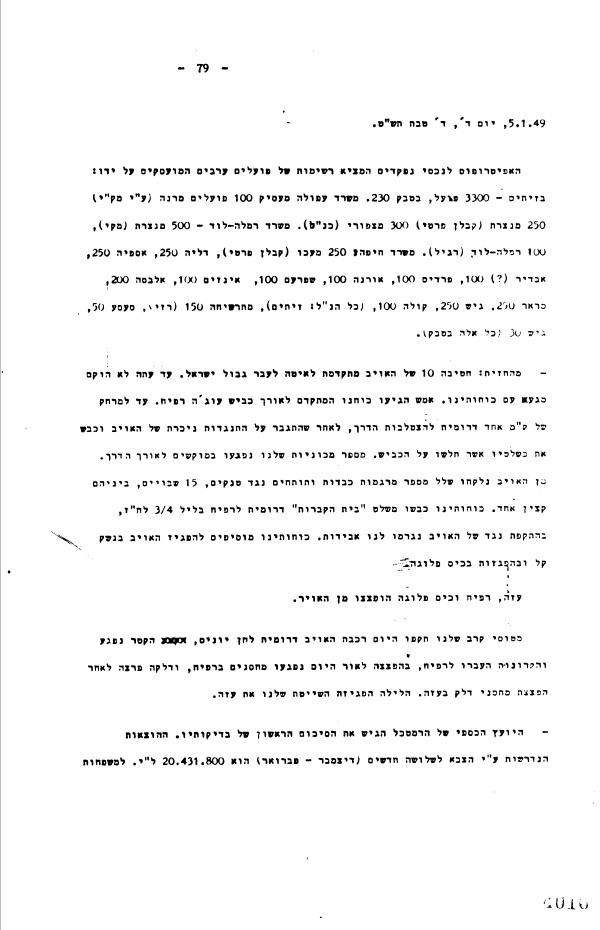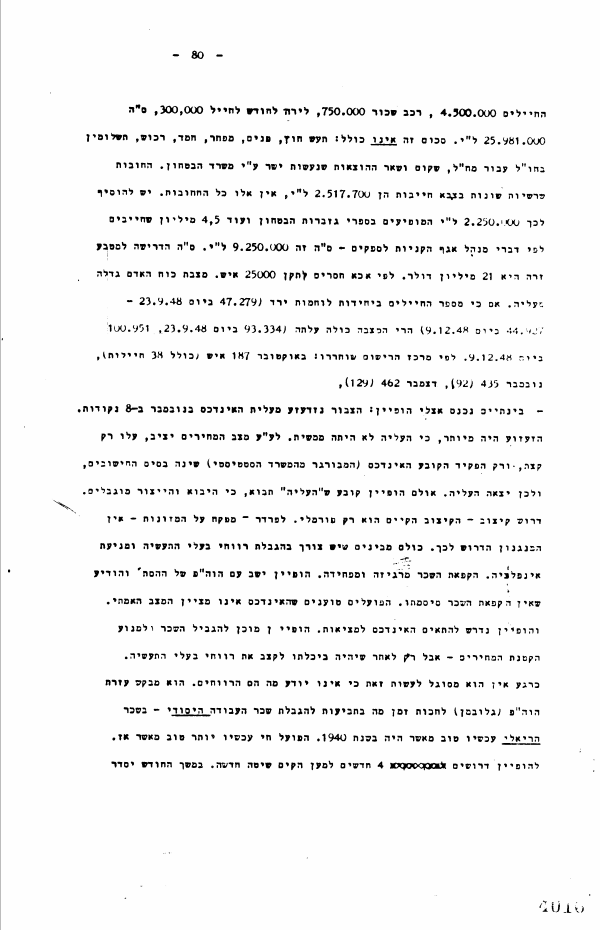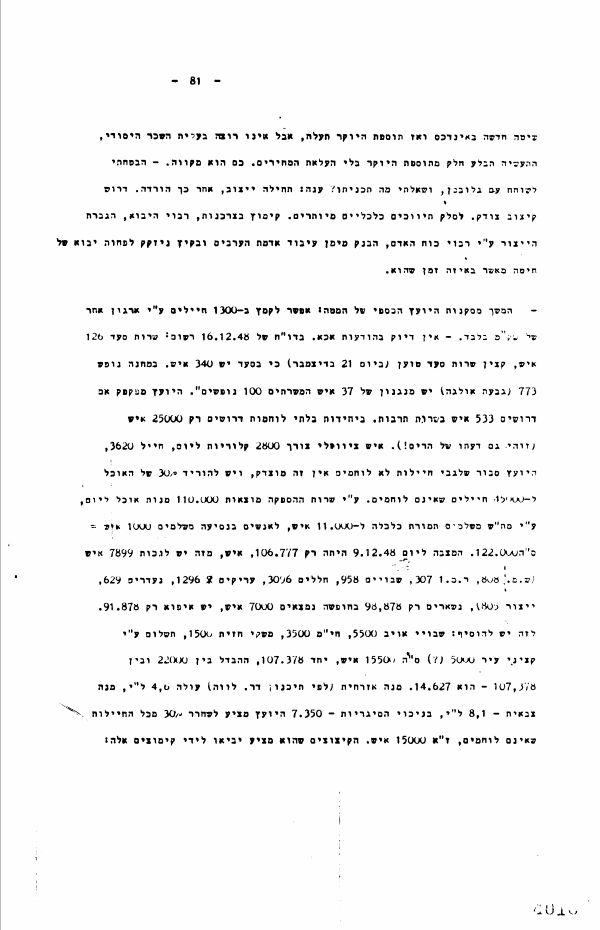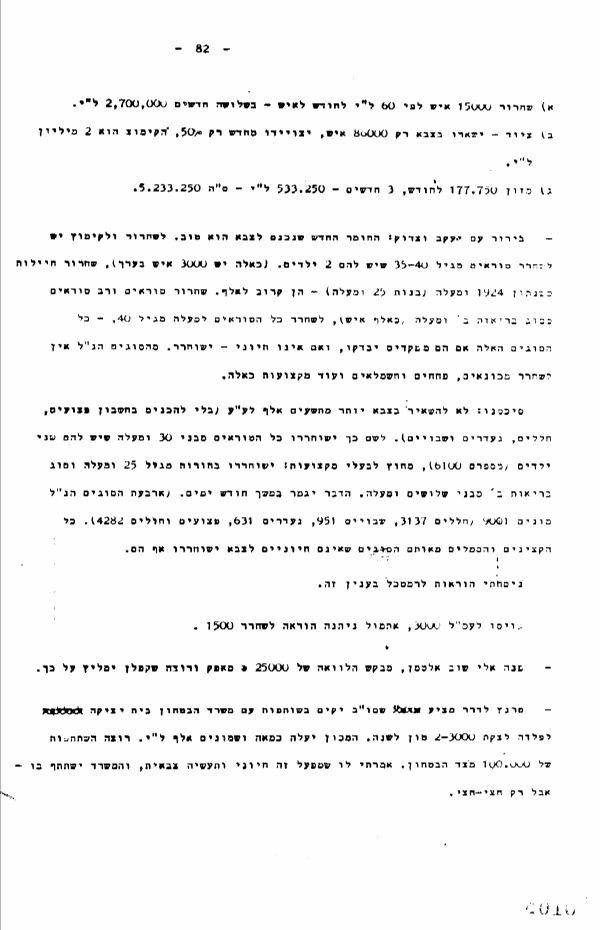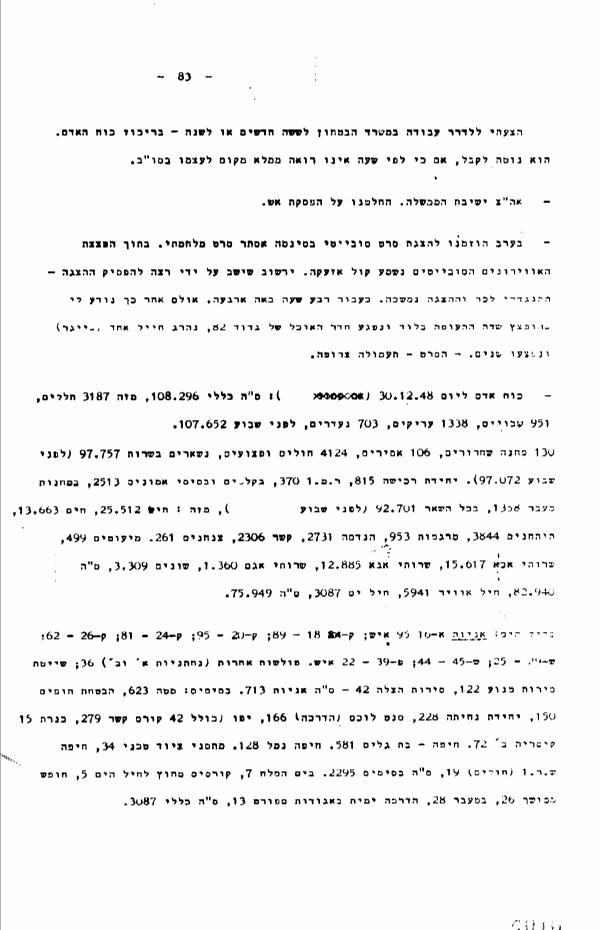Wednesday, January 5, 1949
The Custodian of Absentee Properties produced lists of the Arab workers employed by it: In olives - 3,300 worker[s], in tobacco 230. The ''Afula office employees 100 workers from Reineh [?] (by MAKI [the Israeli Communist Party]), 250 from Nazareth (private contractor), 300 from Tzipori (likewise). The Ramle-Lod office - 500 from Nazareth (MAKI), 100 Ramle-Lod (regular). The Haifa office 250 from Acre [Akko] (private contractor), Daliya [Daliyat al-Karmel?] 250, Isfiya, Abadir [?] (?) 100, Fureidis 100, Orna [?] 100, Shfar'am 100, Ijzim [?], Al-Bassa 200, Maghar 250, Jish 250, Qula 100 (all the above: olives), from Tarshiha 150 (RAZI [?]) Sa'sa' 50, Jish 30 (all of these tobacco).
From the front: The enemy's [Egypt's] 10th Brigade is slowly advancing towards Israel's border. So far there has been no contact with our forces. Last night a force of ours [from Harel] that is advancing along the ''Auja - Rafiah road reached as far as 1 km south of the crossroads [Rafiah Junction], after overcoming significant enemy resistance and capturing the strongholds it held that controlled the road. A number of our vehicles were damaged by mines along the way. The plunder seized from the enemy [consisted of] a number of heavy mortars and anti-tank cannons [and] 15 POWs, including one officer. Our forces [from Golani] captured the "cemetery" stronghold south of Rafiah on the night of 3/4 of this month. The enemy's counter-attack caused us losses. Our forces continue to shell the enemy using light weapons and shells against the Faluja "pocket."
Gaza, Rafiah, and the Faluja "pocket" were bombed from the air.
Today our fighter planes attacked an enemy train south of Khan Yunis; the engine was damaged and the railcars were transferred to Rafiah. During the daytime bombing warehouses in Rafiah were damaged, and fire broke out after fuel depots in Gaza were bombed. Last night our flotilla shelled Gaza.
- The chief of staff's financial advisor submitted the first summary of his assessments. The expenses necessitated by the army for three months (December-February) total P£ 20,431,800. For soldiers' families 4,500,000. Rental vehicle[s] 750,000, lira[s] per month per soldier - 300,000, total P£ 25,981,000.
This amount does not include: foreign manufacture of weapons, domestic [manufacture of weapons], chemical factories, science corps, procurement, overseas payments for MAHAL [Volunteers from Abroad], rehabilitation, and other expenses handled directly by the Defense Ministry. The debts owed by various authorities in the army amount to P£ 2,517,700. These are not all the debts. There is an additional P£ 2,250,000 that appear in the Defense [Ministry] ledgers and another 4.5 million that is owed to suppliers according to the director of the Procurements Department - in total P£ 9,250,000. The demand for foreign currency is $21 million.
According to the Personnel Department, there is a shortfall of 25,000 below the standard. Manpower has increased because of ''aliya [immigration]. Although the number of soldiers in combat units has declined (47,279 on September 23, 1948 - 44,927 on December 9, 1948), manpower on the whole has increased (93,334 on September 23, 1948, 100,951 on December 9, 1948[)]. According to the registration center [the following] were discharged: in October 187 persons (including 38 women soldiers), November 435 (92), December 462 (129).
- In the meantime [Eliezer] Hoofien [head of the Coordination Center, to combat the cost of living] came to see me: The public is shocked because the index has increased by 8 points. The shock was pointless because the increase was not real. For now the prices are stable, they've only risen a little, and it was just that the administrator who determines the index ([Dr. Pinhas (sp.)] Hamburger from the statistical office [Central Bureau of Statistics]) changed the basis for the calculations, which is what produced the increase. However, Hoofien states that the "increase" will come in, because import and production are limited. Rationing is needed - the current rationing is just a formality. [Dr. Yeshayahu] Foerder - the foodstuffs supervisor - does not have the apparatus needed for this. Everyone understands that it's necessary to limit the profits of manufacturers and prevent inflation. Putting a freeze on wages creates anger and fear. Hoofien met with the Histadrut Executive Committee and informed [them] that putting a freeze on wages is not his slogan. The workers claim that the index does not reflect the actual situation, and that Hoofien must adapt the index to reality. Hoofien is prepared to put a limit on wages and prevent a decline in prices [temporarily, see below] - but only after he's able to allocate the profits of manufacturers. Right now he is not able to do this because he does not know what those profits are. He's asking for help from the Executive Committee (Globman [Akiva Govrin]), to wait a while with demands for an increase in basic work wages. The real wages right now are better than they were in 1940. The worker currently lives better than he did then. Hoofien needs 4 months to create a new system. Over the course of a month he will set up a new system for the index, and then the cost of living will rise, but he does not want the basic work wages to rise. Industry will swallow [absorb] part of the cost-of-living increase without raising prices. This is what he hopes. - I promised him that I would speak with Globman, and I asked what he was planning. He replied: first stabilizing [prices], then reducing [them]. It's necessary to have fair rationing, to cut out superfluous economic mediation, reduce consumption, increase import, increase production by increasing manpower. The bank funded the cultivation of Arab land, and this summer we'll need less imported wheat than at any other time.
- Further conclusions of the chief of staff's financial advisor: We can cut out 1,300 soldiers just by reorganizing Shekem [the army's food service]. - The Personnel Department reports are inaccurate. The report of December 16, 1948, stated: ["]Welfare service 126 people, the welfare service officer claims (on December 21) that welfare has 340 people. Recreation camp 773 (Giv'at Olga) has an apparatus of 37 people serving 100 vacationers." The advisor questions whether 533 people are needed in the cultural service. Only 25,000 people are needed for non-combat units (this is also Harris's opinion!). A civilian consumes 2,800 calories per day, a soldier 3,620, the advisor thinks that for non-combat units this is unjustified, and food should be decreased by 30% for the 45,000 non-combat soldiers. The food service produces 110,000 meal rations per day, the payments administration [?] pays for subsistence for 11,000 people, for personnel transport [they] pay for 1,000 people = total 122,000. Manpower as of December 9, 1948, was only 106,777, of whom 7,899 should be deducted (I.S. [Intelligence Service] 808, R.M. 1 [reshima mekubetzet? i.e., collective list, a military unit without a manpower standard (quota) that comprises soldiers temporarily not being counted in other units as part of those units' standard] 307, POWs 958, fallen 3,096, deserters 1,296, missing 629, production 805), there remain only 98,878[,] 7,000 people are on vacation, so there are only 91,878. Added to this: enemy captives 5,500, garrison 3,500, frontline settlements 1,500, payment by city officers (?) Total 15,500 people, altogether 107,378, the difference between 22,000 and 107,378 - is 14,627. A civilian meal ration (as planned by Dr. Lowe [?]) costs P£ 4.6, military meal ration - P£ 8.1, deducting cigarettes - 7.350. The advisor suggests releasing 30% from all the non-combat units. This means 15,000 men. The cuts that he proposes will lead to the following savings:
Discharging 15,000 men at P£ 60 per month per person - for three months P£ 2,700,000. Equipment - only 86,000 men will remain in the army, re-equipped at only 50%, the saving is P£ 2 million. Food 177,750 per month, 3 months - P£ 533,250 - total 5,233,250.
- Consultation with Ya'akov [Dori] and [Moshe] Zadok: The new material [personnel] that has joined the army is good. For the sake of discharging and saving, privates age 35-40 with 2 children should be released. (There are about 3,000 such men.) Release of women soldiers born in 1924 and earlier (ages 25 and older) - they're close to a thousand. Release of all the privates and corporals of category B health and above (about a thousand men), release all the privates above age 40 - all of these categories if they are commanders will be assessed, and if someone is not vital - he will be released. Of the above categories, mechanics, metalworkers, and electricians and similar vocations are not to be released.
We concluded: Not to leave more than 90,000 in the army for now (not counting wounded, fallen, missing, and POWs). Towards this end all the privates aged 30 and above who have two children will be released (they number 6,100), aside from tradesmen. Women aged 25 and above and health category B aged 30 and above will be released. This process will conclude over the course of a month. (The four categories number 9,001: fallen - 3,137, POWs 951, missing - 631, wounded and ill - 4,282). All the officers and sergeants of the above categories who are not vital to the army will also be released.
I drafted instructions to the chief of staff on this matter.
3,000 were recruited for AMAL; yesterday instructions were issued to release 1,500.
- [Dr. Aryeh] Altman approached me again, seeking a loan of $25,000 from APC [the Anglo-Palestine Company, predecessor of Bank Leumi], and he wants [Eliezer] Kaplan's recommendation in this regard.
- Franz Lederer [Zvi Dar] proposes that Solel Boneh [a cooperative Jewish labor company for public works, construction, and industry] in partnership with the Defense Ministry establish a steel casting facility, to cast 3,000-4,000 tons per year. The institute will cost about P£ 180,000. He wants a contribution of 100,000 from the Defense [Ministry]. I told him that this factory is essential for the military industry, and the ministry will participate - but only 50-50.
I offered Lederer a job in the Defense Ministry for six months or a year - in manpower coordination. He's inclined to accept, although at this time he does not know who can replace him at Solel Boneh.
- In the afternoon government meeting. We decided on a cease-fire.
- In the evening we were invited to the screening of a Soviet film at Cinema Esther. A war film. In the midst of bombing by Soviet airplanes [in the film] a siren went off. [Soviet Ambassador Pavel] Yershov, who was sitting next to me, wanted to stop the screening - I objected and the screening continued. After about 15 minutes came the all-clear. But later I learned that an airfield in Lod had been bombed and Battalion 82's mess hall had been hit, one soldier was killed (Geiger) and two were wounded. The film - pure propaganda.
- Manpower as of December 31, 1948: Overall total 108,296, of whom [there were] 3,187 fallen, 951 POWs, 1,338 deserters, 703 missing, a week ago 107,652. 130 [in] discharge camp, 106 prisoners, 4,124 ill and wanted, 97,757 remain in service (a week ago 97,072). Procurements unit 815, R.M. 1 [reshima mekubetzet? i.e., collective list, a military unit without a manpower standard (quota) that comprises soldiers temporarily not being counted in other units as part of those units' standard] 370, intake [facilities] and training bases 2,513, transit camps 1,358, all the rest 92,701 (a week ago [blank space]), of whom: Hayish 25,512, garrison 13,663, artillery corps 3,844, mortars 953, engineering 2,731, signal 2,306, paratroopers 261. Minorities 499, Personnel Department services 15,617, Logistics Department services 12,885, Operations Department services 1,360, miscellaneous 3,309, total 82,940, Air Force 5,941, Navy 3,087, total 75,949.
In the Navy: Ships A-10 95 men; K-18 - 89; K-20 - 95, K-24 - 81; K-26 - 62; S-29 - 25; S-45 - 44; P-39 - 22 men. Other incursion vessels (landing crafts A and B) 36; motorboats flotilla 122; rescue boats 42 - total 713 vessels. Bases: Staff 623, coastal security 150, landing unit 228, St. Lucas (training) 166, Jaffa (including 42 signal course[)] 279, Kinneret [Sea of Galilee] 15, Caesarea B 72. Haifa - Bat Galim 581. Haifa Port 128. Technical equipment warehouses 34, Haifa M.S. [Medical Service?]1 (ill persons) 19, total for bases 2,295. At the Dead Sea 7, courses outside of the Navy 5, extended vacation 26, in transit 28, Naval training at the sports clubs 13, overall total 3,087.
Brigade 1 - 2,065; 2 - 1,580; 3 - 2,466; 4 - 1,948; 5 - 3,339; 6 - 1,856; 7 - 1,876; 8 - 1,658; 9 - 1,539; 10 - 2,321; 11 - 2,135; 12 - 2,171; - garrison - Galilee 1,730, Valley 1,413, Haifa 1,305, Tichon [Central] 2,056; Tel Aviv 1,915; Jerusalem 2,743; Shfela [central plain] 1,144; Negev 805; military police 1,729; registration center 429; psychological research 62; city officers 432; intake [facilities] and training bases 1,461; medical service 5,736; Elisha (?) 136, Shekem [the army's food service] 922; religious services 109; legal 166; Red Cross liaison 25; culture 559; welfare 134; cultural s[ervice] school 30; housing 1,981; supplies 1,109, equipment 1,465, armament engineering 892, armament service 659, transport 5,501, fuel 600, animals 471 (mules 280, dogs 76, cavalry 102), military post 85, oversight over transport and cargo 122; mapping and photography 418, press liaison 62, I.S. [Intelligence Service] 880; Training Department 696; physical training s[ervice] 156, Payments Department 256, military government 75, science corps 428, Gadna [Youth Battalions] 593, Naval Gadna 114, Gadna training camp 241, General Staff camp 250, General Staff 430.





